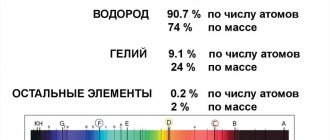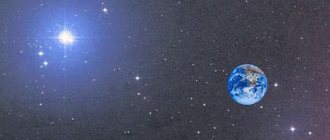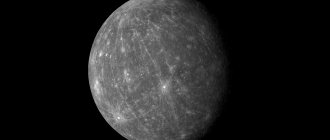The Sun is the closest star to Earth
The Sun is the only star in the Solar System; all the planets of the system, as well as their satellites and other objects, including cosmic dust, move around it. If we compare the mass of the Sun with the mass of the entire solar system, it will be about 99.866 percent.
The Sun is one of the 100,000,000,000 stars in our Galaxy and is the fourth largest among them. The closest star to the Sun, Proxima Centauri, is located four light years from Earth. The distance from the Sun to planet Earth is 149.6 million km; light from a star reaches in eight minutes. The star is located at a distance of 26 thousand light years from the center of the Milky Way, while it rotates around it at a speed of 1 revolution every 200 million years.
Presentation: Sun
According to the spectral classification, the star is a “yellow dwarf” type; according to rough calculations, its age is just over 4.5 billion years, it is in the middle of its life cycle.
sunny wind
The solar wind is a continuous stream of plasma coming from the solar atmosphere and filling the entire solar system. The solar wind is formed because, due to the high temperature in the solar corona,
the pressure of the overlying layers cannot balance with the pressure in the crown itself. Therefore, there is a periodic release of solar plasma into the surrounding space. There is a whole separate article on the phenomenon of the solar wind on our website.
Structure of the Sun
The sun, consisting of 92% hydrogen and 7% helium, has a very complex structure. At its center there is a core with a radius of approximately 150,000-175,000 km, which is up to 25% of the total radius of the star; at its center the temperature approaches 14,000,000 K.
The core rotates around its axis at high speed, and this speed significantly exceeds the outer shells of the star. Here, the reaction of helium formation from four protons occurs, resulting in a large amount of energy passing through all layers and emitted from the photosphere in the form of kinetic energy and light. Above the core there is a zone of radiative transfer, where temperatures are in the range of 2-7 million K. This is followed by a convective zone approximately 200,000 km thick, where there is no longer re-radiation for energy transfer, but plasma mixing. At the surface of the layer the temperature is approximately 5800 K.
The atmosphere of the Sun consists of the photosphere, which forms the visible surface of the star, the chromosphere, which is about 2000 km thick, and the corona, the last outer shell of the sun, whose temperature is in the range of 10,000 K. From the outer part of the corona comes ionized particles called the solar wind.
Evolution of the Sun
When the Sun reaches an age of approximately 7.5 - 8 billion years (that is, in 4-5 billion years), the star will turn into a “red giant”, its outer shells will expand and reach the Earth’s orbit, possibly pushing the planet further away.
Under the influence of high temperatures, life as we understand it today will simply become impossible. The Sun will spend the final cycle of its life in the “white dwarf” state.
Location of the Sun in the galaxy
Despite its enormous size relative to our planet (and other planets), on a galactic scale, the Sun is far from the largest star, but very small, there are stars much larger than the Sun. Therefore, astronomers classify our star as a yellow dwarf.
As for the location of the Sun in the galaxy (as well as our entire solar system), it is located in the Milky Way galaxy, closer to the edge of the Orion Arm. The distance from the center of the galaxy is 7.5-8.5 thousand parsecs. In simple terms, we are not exactly on the outskirts of the galaxy, but we are also relatively far from the center - a kind of “dormitory galactic area”, not on the outskirts, but not in the center either.
This is what the location of the Sun looks like on a galactic map.
The sun is the source of life on Earth
The sun is the most important source of heat and energy, thanks to which, with the assistance of other favorable factors, there is life on Earth. Our planet Earth rotates around its axis, so every day, being on the sunny side of the planet, we can watch the dawn and the amazingly beautiful phenomenon of sunset, and at night, when part of the planet falls into the shadow side, we can watch the stars in the night sky.
The sun has a huge impact on the life of the Earth, it participates in photosynthesis and helps in the formation of vitamin D in the human body. The solar wind causes geomagnetic storms and it is its penetration into the layers of the earth's atmosphere that causes such a beautiful natural phenomenon as the northern lights, also called the polar lights. Solar activity changes towards decreasing or increasing approximately every 11 years.
Solar Exploration
Since the beginning of the space age, researchers have been interested in the Sun. For professional observation, special telescopes with two mirrors are used, international programs have been developed, but the most accurate data can be obtained outside the layers of the Earth’s atmosphere, so most often research is carried out from satellites and spacecraft. The first such studies were carried out back in 1957 in several spectral ranges.
Today, satellites are launched into orbit, which are observatories in miniature, making it possible to obtain very interesting materials for studying the star. Even during the first years of human space exploration, several spacecraft were developed and launched aimed at studying the Sun. The first of these were a series of American satellites, launched in 1962. In 1976, the West German Helios-2 apparatus was launched, which for the first time in history approached the luminary at a minimum distance of 0.29 AU. At the same time, the appearance of light helium nuclei during solar flares, as well as magnetic shock waves covering the range of 100 Hz-2.2 kHz, were recorded.
Another interesting device is the Ulysses solar probe, launched in 1990. It is launched into a near-solar orbit and moves perpendicular to the ecliptic strip. 8 years after launch, the device completed its first orbit around the Sun. He recorded the spiral shape of the luminary's magnetic field, as well as its constant increase.
In 2020, NASA plans to launch the Solar Probe+ apparatus, which will approach the Sun at the closest possible distance - 6 million km (this is 7 times less than the distance reached by Helius-2) and will occupy a circular orbit. To protect against extreme temperatures, it is equipped with a carbon fiber shield.
Abstract on natural history on the topic “Stars. The sun is the closest star to us" (5th grade)
Lesson summary
natural history in 5th grade
Lesson topic: Stars. The Sun is the closest star to us.
Purpose of the lesson: to promote students’ knowledge of stars, constellations, and the Sun.
Equipment: textbook drawing, star map, star globe, colored pencils, glue, confetti, media projector.
During the classes
1.Organizational stage (1-2 min):
The bell gave us a signal, the hour has come to work
2.Checking homework (8-10 min):
Answer the questions
- What is shown in the picture? Characterize this celestial body (slide No. 1)
- What phenomenon is depicted? The reasons for its occurrence (slide No. 2)
- What is meant by a meteorite? (slide No. 3)
- What is an asteroid? (slide No. 4)
3.Learning new material (20-23 min)
Listen to the riddles and guess them.
(slide No. 5)
- Sparks burn through the sky, but do not reach us. (Stars)
- The blue ceilings are nailed down with gold nails. (Sky and stars)
- White flowers bloom in the evening and fade in the morning. (Stars)
- What is visible only at night? (Stars)
- The owner is sleeping - the sheep are in the pasture
The owner will look out - there are no sheep in sight,
The owner will hide - the sheep will appear again (Sun and stars)
- Not a fire, but it burns painfully, Not a lantern, but shining brightly, Not a baker, but baking (the Sun)
Have you guessed what topic we will study in class today?
(slide No. 6)
Write down the date and topic of the lesson in your notebooks:
(slide No. 7)
Stars. The Sun is the closest star to us
Teacher's message: In ancient times, people believed that the stars were silver nails driven into the vault of heaven.
They tried to draw stars on stones, and later write hymns, poems, and poems about the stars.
I want to invite you to draw the starry sky as you imagine it, using colored pencils. (
5 minutes to work - discuss the drawings)
When the weather is cloudless, you can see a lot of stars in the sky at night. Have you ever looked at the sky and counted the stars?
(Children's answers). (slide No. 8)
What can you tell us about the stars? What do you know about them?
(Students' answers)
Let's write the definition in our notebook:
These are huge flaming balls located very far from our planet. (slide No. 9)
There are a great many stars in the sky. They are located very far from our planet, so they appear only as flickering dots in the night sky. People can see 6 thousand stars with the naked eye, but binoculars or a telescope can see much more. Scientists know many billions of stars. All stars are part of constellations. There are only 88 of them. 54 constellations are visible from the territory of our country. Look at the star map. Find the constellations Ursa Major and Ursa Minor.
(slide No. 10)
These constellations can be used to determine the sides of the horizon.
To determine the sides of the horizon using the North Star, it is necessary to find the constellation Ursa Major in the firmament.
Then mentally continue the straight line segment between the two extreme stars of the “bucket” (a and b) towards its expanded part and set aside five times. The resulting point will indicate the position of the North Star, which is part of the constellation Ursa Minor and is always located in the north direction. (slide No. 11)
Zodiacal constellations are of particular interest
(slides No. 12,13) -
the Sun makes its annual journey along them.
Practical work:
in your notebooks, make an applique of your zodiac constellation, or a constellation of your own choosing. Use confetti, glue, colored pencils. (5 minutes)
The Sun is the closest star to us
(slide number 14)
.
This is the only star that we can observe during the day, while the others we see only at night. The sun is the center of our solar system. (slide No. 15, No. 16)
Working with the textbook:
(slide No. 17)
Read the text of the textbook pp. 48-49, answer the questions.
- What are the dimensions of the Sun?
- Why does it seem to us that the Sun is the same size as the Moon?
- What do you think the temperature of the Sun is?
In the sky, the Sun appears round and almost the same size as the full Moon. But the diameter of the Sun is about 400 times the diameter of the Moon and 109 times the diameter of the Earth.
Teacher : Remember, at what distance from the Sun is the Earth?
(slide No. 18)
(Answer: at a distance of 150 million km from Earth).
Teacher : The sun is the greatest source of light and heat, giving life and development to all life on Earth.
Question:
What is the significance of the Sun? What would happen on Earth if the Sun went out?
(slide No. 19) (children’s answers)
Generalization of children's answers (slide No. 20)
4.
Lesson summary:
- Summarize the knowledge gained in the lesson
-Grading
-Reflection (slide No. 21) (draw the appropriate emoticon in your notebook)
5. Homework:
(slide No. 22)
- Textbook – pp. 48-49. Read, retell
- Watch the starry sky. What constellations do you know?
- Prepare riddles and puzzles about the stars.







